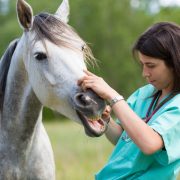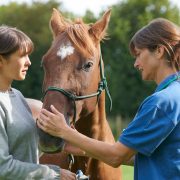Field testing two animal-specific non-contact thermometers on healthy horses
Field testing two animal-specific non-contact thermometers on healthy horses

Requires membership/payment
This article can be accessed via RCVS Knowledge Library Membership (click here).
In our edition of: Jun 2019
In our categories of: equine
our summary:
Carter, A.J., Dimitrova, A. and Hall, E.J. (2019) Field testing two animal-specific non-contact thermometers on healthy horses. Veterinary Nursing Journal, 34 (4), pp. 96-101
The primary aim of this study was to investigate the accuracy of two animal-specific non-contact infrared thermometers (NCIT) – Thermofocus and Rycom – when compared to rectal temperature in healthy horses. These NCIT are available for use by animal owners as well as veterinary surgeons thus a secondary aim of the study was to investigate the impact of poor operator technique on the accuracy of the device.
The study was carried out on 22 healthy horses from one location. All equine temperatures were taken in a stable with an ambient temperature range similar to conditions in a UK yard. Repeated equine temperature readings were performed on ten separate days over a seven-month period. The rectal temperature was taken first in all cases, using a standard digital thermometer, by the same equine technician.
Following this the eye temperature was measured using the two NCIT devices. Firstly using the Rycom thermometer as this does not emit light or sound and then using the Thermofocus thermometer. In both cases the eye temperature was measured at the medial canthus, lateral canthus and central globe area of both eyes. Finally, eye temperature was taken with both devices with the instrument deliberately held too far away from the central globe area. The internal ear temperature and the temperature of the surface skin of the rectum were also taken with the Rycom device.
Temperature readings were also taken on one occasion following a period of exercise, intended to obtain an elevated temperature, so that measurements from hyperthermic horses with a temperature greater than 38°C could be compared.
The results from the study showed a high percentage of agreement between rectal temperature and eye temperature measurements taken with the Rycom thermometer. The Rycom device gave over 75% eye temperature readings within ±0.5ᵒC of rectal temperature when measured from the medial and lateral canthus regions of both eyes. In contrast, the Thermofocus gave less than 50% of eye temperature readings within ±0.5ᵒC of rectal temperature.
The Rycom NCIT detected all the horses identified as hyperthermic by rectal temperature; however, it also incorrectly identified 17 of the normothermic horses as identified by rectal temperature as hyperthermic. Improper positioning of the Rycom NCIT significantly reduced the agreement between rectal and eye temperatures.
Limitations of the study included the small sample size and the fact that they were all healthy horses.
This study provides useful information on the use of NCIT thermometers for horses. In this population the Rycom thermometer provided the most accurate results when used as recommended by the manufacturer. Further studies with a larger population including clinically hyperthermic and hypothermic horses are to be encouraged
Image copyright attribute: Natalie Alexeeva
Join the discussion
We encourage discussion on all material highlighted in each edition of inFOCUS. Use the button below to join the conversation on Twitter and include your comment in the feed for this issue.









Leave a Reply
Want to join the discussion?Feel free to contribute!